Basement brick - what is it for? Which brick is better for building a basement?
11 June, 2014 - 19:12The foundation, which is located above the ground surface, is called the plinth. Given its close proximity to the ground, it requires special attention to its construction.
In particular, to the materials used in this case. Today, despite the fact that brick cannot be considered the optimal building material for arranging the basement of a building, it is for a number of reasons that it is most often used for these purposes. To save future home from possible risks, you need to understand which brick to choose in each certain case. Right choice will provide good thermal and waterproofing, which is exactly what the base should do, regardless of whether you laid it out yourself or used the work of professionals.
So, which brick to choose for the plinth? It is impossible to give a definite answer to this question. Experts and builders disagree, given the fact that the characteristics of the base, and therefore the brick from which they decided to build it, are influenced by many factors. These are the properties of the cement mortar used, and climatic conditions operation of the future home, and even the installation method. We will not touch on how to lay the base in this article. We only note that for most cases, laying a plinth made of brick of a grade not lower than M100 is considered optimal with M75 cement mortar.
Brick selection criteria
As a building material, brick for the plinth must meet certain parameters. This is, first of all, strength, moisture absorption and frost resistance. The higher the strength, the greater the load the brick can withstand before the stage of its destruction begins. However high rate moisture, on the contrary, indicates that it is better to look for another material, especially in harsh climatic zones. The fact is that the higher the moisture absorption rate, the lower the frost resistance of the building material. The latter is measured by how many times a brick can freeze and thaw before it begins to deteriorate. You will learn how to produce from the materials on the site.
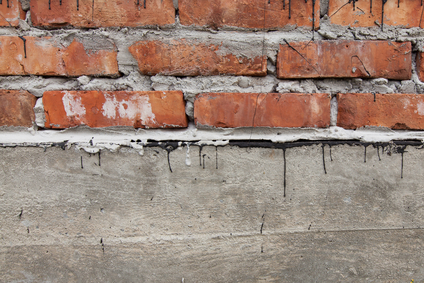
Clinker brick
Undoubtedly, the base of a house made of brick of this type, with a very high visual appeal, is also distinguished by the greatest strength. True, its cost is higher than others. But the main advantages of clinker bricks - durability, attractiveness and reliability - are worth it. Its moisture absorption capacity is only 3-5%.
Acid resistant brick
It feels equally good at both low and low temperatures. high temperatures, and is deservedly considered “eternal”. But when purchasing such a brick, you need to be extremely careful. The fact is that its production must comply with the most stringent state standards, violation of which can lead to the brick emitting harmful substances into the environment, literally poisoning people. Therefore, the manufacturer of this brick must inspire absolute trust.
Sand-lime brick
High density, thermal conductivity and moisture absorption are the main advantages of this building material. However, when using it when constructing a base, you need to take into account the fact that it will definitely require finishing - its appearance leaves much to be desired. Made from sand and lime, sand-lime brick has a fairly low cost, but is necessary decorative finishing may negate this advantage.
Ceramic solid red brick
Universal building material. It is also used when raising the base. But it must be taken into account that in conditions high humidity for the construction of a basement it is better to use a certain type of it. For example, well fired. It’s possible - even slightly burnt.
The lower floors are the most important element in the structure, because they ensure its stability and counteract various weather phenomena. In this article we will look at how to make a brick plinth with your own hands. This material is the most optimal solution to perform this function.
Choosing material
The first step is to figure out which brick is best for the base. To do this, we present to your attention a list of the main criteria for selection.
Specifications
- The lower floors of the building are constantly exposed to moisture, so the materials used to create them must have minimal water absorption.
Tip: to improve this indicator, coat the structure with hydrophobic compounds. They can be bought at any hardware store.
- Do not forget that the plinth has an impressive exercise stress. In this regard, materials are required to have high strength and bending resistance. This parameter can be determined by the brand of brick. And the most popular is the M 150.
- Since we live in a country with a harsh climate, any materials for outdoor use must be able to withstand significant temperature fluctuations. So, the brick for the plinth must have a frost resistance rating at least 35 cycles(in marking this characteristic marked with a letter F).
- The brick plinth must have an impressive thermal conductivity, because this part of the building greatly affects temperature regime in a buiding. It is recommended to use, as they retain heat much better. It is not advisable to use hollow ones.
In order to determine whether the selected material meets the stated requirements, you need to ask the seller about its characteristics. Yes, he is perfect for this role. clinker brick. Its structure is similar to glass, due to which it is able to withstand severe frosts and not absorb moisture.
You can also use double sand-lime brick M 150. However, if a serious load is expected on the base (when it comes to multi-story construction), this material is not suitable, since it does not have sufficient strength.
If you are wondering why you need a brick base, then think about the fact that this element will take on the entire load. It must be as stable as possible to prevent the structure from subsiding. In addition, this solution seems to be the most aesthetic.
A few words about the cost
Nowadays, it is often the price of a product that becomes the main selection criterion. However, we strongly do not recommend purchasing low-grade bricks to create a plinth. Otherwise, there is a high risk of structural failure.
If for you the cost is important criterion, then think about this: for a plinth it is twice as large in size, and at the same time its cost only 1.5 times higher. This suggests that it is more profitable to use double red brick for the plinth. In addition, it requires less solution.
Design methods
Today there are three ways in which a brick plinth is laid. They differ in the thickness of the substrate relative to the main “box” of the building.
- Recessed base. In this case, its thickness will be less than that of the main building. This helps protect it from the harmful effects of moisture.
- bulging– in this case, the thickness, on the contrary, will be greater. This technique is usually used for structures with thin walls. When using this scheme, the brick lining of the base must be covered with protective drainage.
- Merging. This method is not very effective, since it implies openness of the waterproofing and cladding, which significantly reduces the service life of the base.
Our instructions smoothly move on to the study of basic work. First you need to prepare a solution. Use the following recipe:
- 1 bucket of cement;
- 5 buckets of sand or 7 buckets of tyrsa;
- 1-2 buckets of water (depending on the desired consistency);
Based on the above proportions, you need to mix the ingredients. As a rule, 12-13 buckets of sand are mixed for 25 kg of cement. To do this, it is better to use a tub (a large container for kneading).
Tip: if you are working with a partner, use a stretcher to carry the solution. This will make the work much easier.
Before laying the brick on the base, you need to spread sheets of roofing felt over the entire area. They will protect the material from the harmful effects of the environment.
So, it’s time to proceed directly to the laying:
- The first step is to set the angles at which the masonry will be made. This stage consists of installing bricks along the width of the plinth without using mortar. In this case, it is very important to check the level, since mistakes made at this stage will be extremely difficult to correct.
- Then put building brick already using the solution. Optimal width of this design is 50 cm, height 30-40 cm. However, you can create a higher base and make a full-fledged room out of it, for example, a billiard room.
- When laying, you need to move a new row of bricks onto the floor. In this case, the vertical seams should be on the same line. Don't forget to do ventilation holes every three meters.
- When the masonry is completed, it needs to be insulated. Great for this expanded polystyrene is suitable. It should be secured from the inside with glue.
- The last stage is waterproofing. It has a serious impact on performance.
This can be done in several ways:
- Treat the surface with a thick layer of bitumen grease.
- Cover with roofing felt. It is worth saying that this is the most popular option, since it is average in terms of price and quality.
- Applying several layers of plaster.
If you want to achieve maximum efficiency, then you can combine the above methods.
Finally, finishing can be done. Perfect for this plinth panels under brick (they are similar to siding). This measure will protect the base material from various external influences and will give the facade a finished look.
The base is the part of the foundation of any structure located above ground level. To make the base truly strong, reliable and durable, you need to choose the right material to create it. Most often, burnt and solid brick, which will be resistant to large amounts of moisture from melted snow, rain, and groundwater.
Brick for the plinth
Let's figure out which brick is better for the base? , used for the construction of a basement, must have the ability to absorb moisture in a minimum amount, and also be able to withstand large temperature fluctuations. As a continuation of the foundation, it is allowed to use clinker bricks or special inexpensive and high-quality Besser blocks industrial production(they are lined with splitter blocks on the outside). Will help you make the right choice suitable material for the plinth, a list of all the physical characteristics that each type of brick has.
So clinker brick in its structure resembles glass, thanks to which it can withstand severe frosts and not absorb moisture. In addition, it adheres well to mortar or clay, forming a strong and reliable structure. In the same time ordinary brick with constant temperature fluctuations it quickly collapses, partially losing its bearing capacity, as a result of which it requires frequent repairs and replacements.
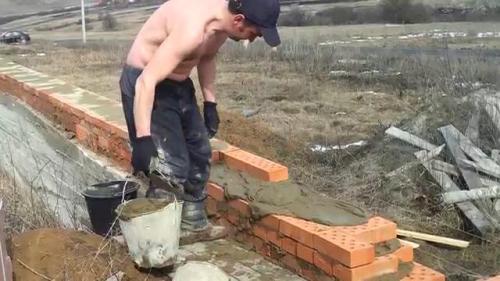
Before you start creating a base, you need to study the basic technical recommendations on this matter, which will ultimately make the foundation of the house durable and of high quality.
1. If you need to make a base in brick building, then its thickness should be at least 51 cm. For a house made of timber, it is allowed to reduce the thickness to 25 cm.
2. Before you start laying bricks, you need to prepare the correct mortar for the plinth. It should include 1 part cement, preferably M400 grade, and 4 parts sand. Ready mix, diluted with water, should not be very liquid. Its ideal consistency is similar to thick sour cream.
The quality of the prepared solution is determined visually. To make the solution more elastic, ordinary washing powder at the rate of 1 tbsp. for 1 bucket of solution or detergent 50-100 ml per batch.
3. Required amount masonry material is calculated quite simply. If you use 400 bricks per 1 m3, then 0.3 m3 of mortar will be used.
4. To protect the base from high humidity, it is recommended to lay waterproofing on the foundation (it is better if it has several layers). The most suitable materials for this are roofing felt or roofing felt.
Brick plinth laying. Video
It is believed that the most important part of any building is the foundation. But the base also takes on no less load, and is constantly in contact with groundwater, precipitation, atmospheric influences. At the same time, if no one sees the foundation, then the basement part is always visible and the closest attention is paid to it. Most often for this segment they use plinth brick, which is characterized by higher strength and density. How to correctly calculate the material and which brick is better for the basement of a house - in our article.
Rules for choosing a brick
To anyone building material increased requirements are imposed, and brick for the plinth is no exception. Firstly, it must be resistant to deformation. Secondly, maintain geometry, color and structure throughout the entire service life in aggressive conditions. Third, be aesthetically attractive and maintain overall stylistic direction the entire building.
Why brick? Because it is one of the few materials that meets all basic conditions exterior finishing, is decorative and cheaper than other natural analogues.
Taking into account the fact that today the range of cladding is very large, you need to understand exactly how and what to use for the base. In particular, we are talking about the brand, resistance to temperature peaks, water absorption ability and durable structure. The two options that best meet these criteria are:
- clinker, which is closer in composition to durable glass;
- full-bodied red.
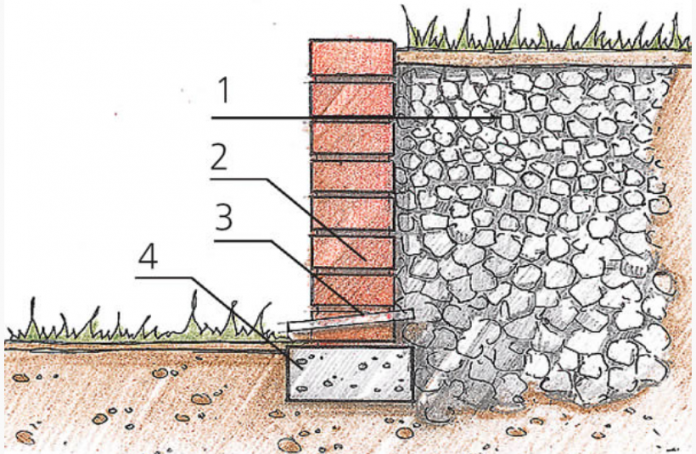
Diagram of a brick retaining foundation: 1 - Crushed stone, 2 - Brickwork, 3 - Drainage hole in the masonry, 4 - Concrete foundation.
Among other things, these two types meet the basic requirements:
- standard sizes, which makes installation very easy and makes it possible to calculate the entire budget in advance;
- preservation of original parameters - even after decades of operation, the cladding should be the same as it was just from production;
- absence of harmful components that can cause harm to health or environment;
- the ability not to retain moisture, which, on the one hand, preserves its structure during sub-zero temperatures, on the other hand, protects walls from mold;
- high degree of adhesion with cement mortar- given that proper preparation it does not dry out, therefore no water gets between the masonry and the wall and no cold bridges are formed.
VIDEO: How to build ground floor made of brick
Product range overview
In order to understand all the variations and choose the most suitable facing brick for the plinth, you need to know specifications each of them. So, we are talking about silicate, ceramic and clay options. There is also a manual molding (hand form). This is the most expensive, but at the same time the most durable of all. possible types, which is ideal for such purposes.
Silicate
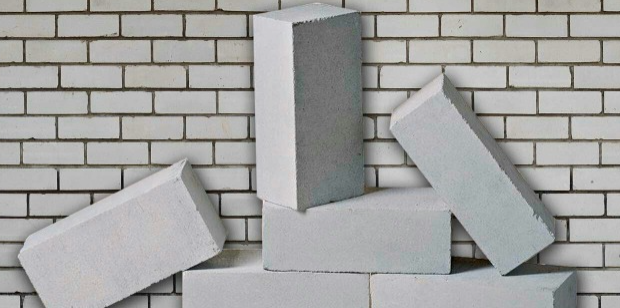
This is the only product that is not fired, but is prepared using pressing technology; accordingly, it is not suitable for constant contact with moisture. Silicate blocks can only be used if the climate is relatively dry, and high quality insulation contact area. Since there are practically no such regions in Russia, and silicate is the cheapest building material among analogues, this means that more attention needs to be paid to waterproofing and regularly treated with water repellents.
Sand-lime brick Great for building a house, but it is better to decorate the basement with ceramic or red clay.
Clay
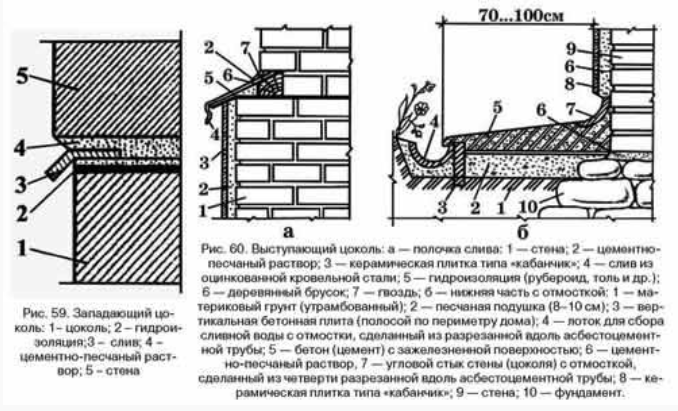
This type, unlike silicate, is made according to traditional technology- by firing, accordingly, it is more suitable for regular contact with moisture. This does not change the fact that it absorbs water, but passes it through itself. In order to use it for the base, you need to choose a suitable brand based on frost resistance:
- M150 - designed for 60-90 freezing/defrosting cycles;
- M250 - for 150-180 cycles.
Cyclicity means freezing to -40°C followed by thawing. The last option is not produced by all factories in Russia, but for finishing the lower part of the house it is better to find just such a brick. Price - 0.36 rub. a piece.
Specifications:
- size - 25x12x6.5 cm;
- weight - 360-375 g;
- density - 1850-1870 kg/cub.m;
- water absorption - 8%;
- thermal conductivity - 0.53 W/(m K).
The clay block does not interfere with air exchange in the room, thereby ensuring favorable microclimate, the walls do not rot or become moldy. Requires treatment with water repellents.
For reference! Why are moisture absorption and resistance to temperature peaks prioritized? The higher these indicators, the longer the material will last. During precipitation, moisture gets inside the block and, if it has no way out, when the temperature drops, it expands and gradually destroys it from the inside. Materials with minimal cycles Freezing/defrosting literally breaks down into separate fragments every year. It is enough to remember our roads to understand what we are talking about.
Ceramic
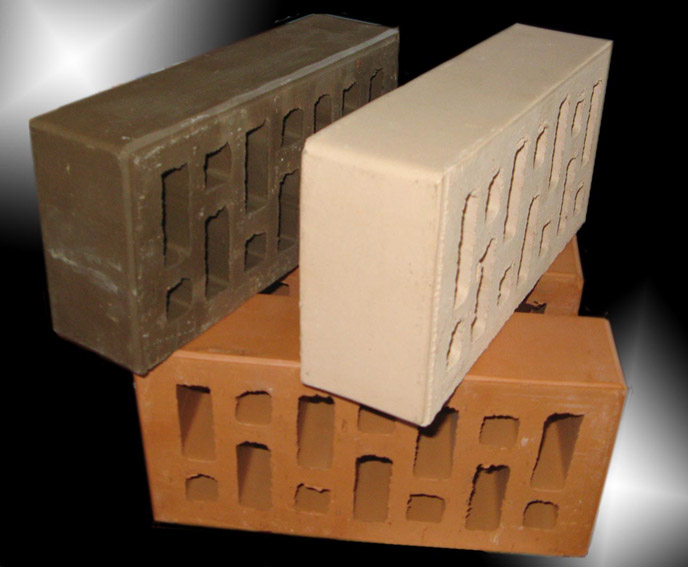
The production technology has been developed to such an extent that this material is structurally reminiscent of durable glass. The raw material is special clay with additives, which is fired at a temperature of 950-1050°C, as a result of which the refractory and low-melting minerals contained in the clay melt, forming a glassy and crystalline structure. During the firing process, the proportion of glass phase decreases to 10%, as a result of which the material becomes very durable and frost-resistant.
According to application, ceramic is divided into:
- ordinary (construction) material, from which objects are built;
- front - facing, but can also be successfully used for the construction of individual elements.
A quality block can be identified by appearance and sound. If the color is pale pink and marks remain on your hands, the brick was simply not finished; it will strongly absorb moisture and burst in the cold. Burnt, on the contrary, is dark in color, but is completely covered with cracks of varying lengths. If the firing process is followed, the block turns out to be a uniform red color with an even structure.
The disadvantages include the following:
- Price. If you buy directly from the manufacturer, the price is from 12 rubles. a piece.
- The appearance of efflorescence - this phenomenon is often called a violation of production technology, but in fact, any ceramics contains lime and salt, which appear as white stains. Timely hydrophobization will help get rid of this.
- Mismatch of shades in different batches. To cladding the basement or the entire building, you must immediately order the entire required volume + 10% for defects and damage, since shades can vary significantly.
To calculate the amount of material required, use the online service.
>>Brick calculator for plinth<<
Manual molding (hand form)
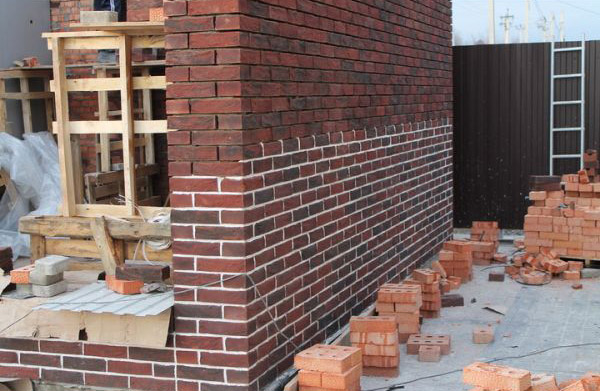
The raw material used is pure shale clay without foreign impurities. Depending on the color of the source material, the shade of the finished product is formed - from gray and milky to rich terracotta.
How to make the foundation of a building correctly
So, the material has been chosen, the dimensions of the red brick for the plinth have been sorted out, now it’s time to understand exactly what requirements are imposed on the organization of this part of the house:
- The thickness of the contact part depends on the thickness of the entire wall and, accordingly, the material from which it is assembled. If it is a beam or log, then 250 mm is enough, but if it is a brick, then no less than 50 cm. Height - 40 cm, the higher this element, the more advantageous the whole structure looks.
- The service life and quality directly depend on the solution on which the stone will be laid. It is this that, if mixed incorrectly or if there is an error in the ratio of the components, will begin to freeze, crack, and form cold bridges.
The optimal ratio is cement (1 part), sand (6.7 parts) and lime (6.7 parts). Water is added until the solution becomes like sour cream. You can adjust the consistency with clay or lime if it is made very liquid. Be sure to add factory-produced plasticizers or washing powder at the rate of 1 tbsp. for each bucket of solution.
- To protect the foundation and plinth, waterproofing must be laid - sheet roofing material, hot resin or roofing felt.
- Already laid masonry is treated with a water-repellent agent; it protects the wall from water ingress, but does not interfere with air exchange.
- The width of the masonry is 2 bricks - optimal, 1.5 - if there is a need to save money. The size of the plinth brick should be standard - narrow or thin options are not suitable here.
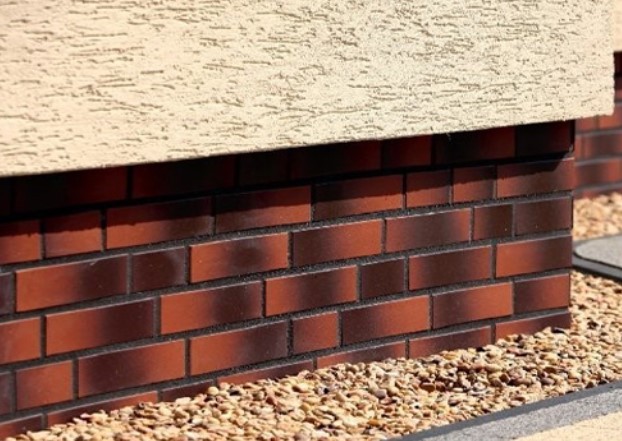
As we can see from the article, all stages of construction are important - the choice of high-quality bricks for the base, the correct mortar, the thickness and even the height of this part of the building. A house is never built to last for a couple of years; it is always a monumental building, where every element is designed for long-term use. The foundation and plinth are the basis of everything, so they should be given the closest attention.
VIDEO: Comparing a base made of brick and concrete - which is better?




